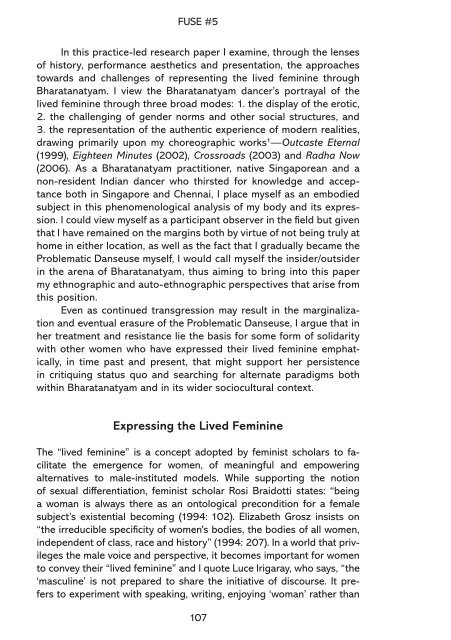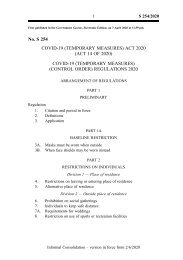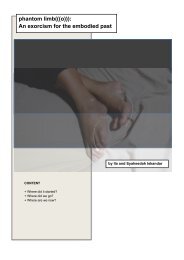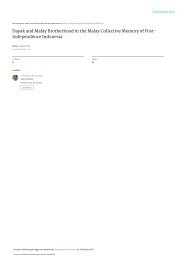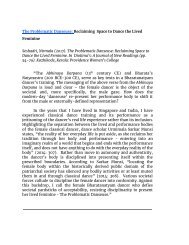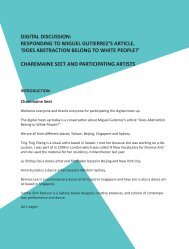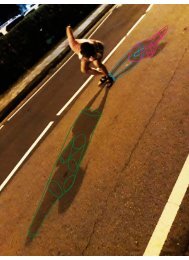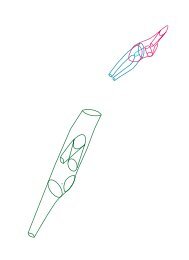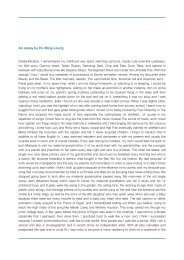FUSE#5
This edition of FUSE consists of articles contributed by artists who participated in Dance Nucleus' programmes in 2020.
This edition of FUSE consists of articles contributed by artists who participated in Dance Nucleus' programmes in 2020.
You also want an ePaper? Increase the reach of your titles
YUMPU automatically turns print PDFs into web optimized ePapers that Google loves.
The Problematic Danseuse<br />
leaving to that other any right to intervene, to ‘act’ in her own interests”<br />
(1985: 157). The opening verse from the Abhinaya Darpana comes to<br />
mind. Expressing the lived feminine carries multi-pronged potential—<br />
empowerment in women arising from the agency and authenticity of<br />
expression, the gradual development of awareness and possible transformation<br />
in society. Dance, with its emphasis and connection to the<br />
corporeal, its negotiation with physical space and tools for non-verbal<br />
communication can serve as a powerful and effective medium for lending<br />
tangibility to the female dancer’s reality. Indeed, these expressions<br />
offer a fresh perspective, “the point of view of the feminine subject”<br />
(Lehtinen 2014: 85).<br />
I examine issues surrounding the expression of the Bharatanatyam<br />
dancer’s lived feminine through three approaches, namely: portrayal of<br />
eroticism, critiquing of gender norms, and expression of her personal<br />
lived experience. I discuss the creation and presentation of my artistic<br />
work, reactions evoked within the socio-cultural context (including<br />
audiences), my interactions and observations in the field as well as<br />
challenges posed to such expression in the context of the globalized 2<br />
dance form—Bharatanatyam.<br />
1. Her Dance is TOO Erotic<br />
After all, I was depicting Radha 3 and Krishna 4 in a post-coital moment.<br />
I felt the strong need to include my own experience as a woman and<br />
to allow for the expressions to be less stylized, to depict an everyday<br />
reality. Instead of restricting my abhinaya to focus on the face<br />
and hand gestures alone, I extended it to include the rest of my body.<br />
Radha in this verse has been referred to as the Swadhinapatika nayika<br />
[heroine], one who is in command of her lover. I therefore introduced<br />
body positions and movements that I felt would convey this stance in a<br />
sexual connotation. Since Radha was seeking to prolong the moment<br />
and have Krishna indulge her in various ways, I interpreted the verse to<br />
be the interim between two sexual climaxes and this was represented<br />
through bodily abhinaya 5 (Seshadri 2011: 6; 2018: 118 – 9).<br />
In the experimental Bharatanatyam duet Crossroads (2003) that was<br />
primarily an exploration of gender through the recontextualization<br />
of the conventional Bharatanatyam margam (repertoire), I chose to<br />
perform as my solo piece the ashtapadi 6 Kuru Yadunandana from<br />
Jayadeva’s Gita Govinda 7 . While earlier versions were performed in<br />
the prescribed and acceptable manner, it was when preparing for<br />
the 2006 staging in Chennai at Sri Krishna Gana Sabha 8 that I was<br />
108


